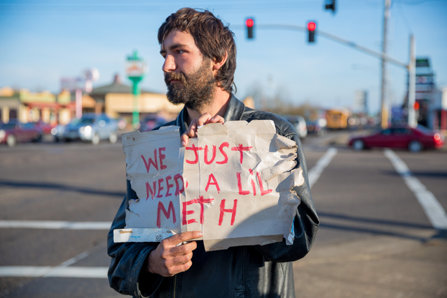Powerfully Dangerous Meth Linked to Homelessness and Mental Illness

Methamphetamine has always been a powerfully destructive drug. However, the power of this drug to destroy today far outpaces its destructiveness in the past. That’s primarily because of a new method of producing a far more potent form of this drug.
Some Background on Methamphetamine
Illicit manufacture of this drug was initiated on the West Coast in the 1960s. Biker gangs in the Northwest set up the first modest production facilities, using the precursor chemical phenyl-2-propanone (P2P) in the production. This production method produced meth similar in strength to what is now being produced. When this chemical became hard to get, small labs began to use ephedrine or pseudoephedrine—chemicals commonly used in cold medications—in their meth manufacturing process. These chemicals were relatively easy to get and meth manufacture expanded greatly, reaching from the West Coast into the Midwest.
When ephedrine and pseudoephedrine sales were restricted in 2004–2005, methamphetamine production dropped off significantly. As production dropped, so did meth use and problems with addiction, which were soon replaced by a raging opioid problem.
The prescription opioid problem was followed by the foreign manufacture of huge quantities of fentanyl which severely boosted overdose deaths in America. Over time, some of the labs that were manufacturing the synthetic opioid fentanyl began to add the manufacturing of a new, more powerful and potent form of methamphetamine. It seemed like the thinking was that it was no problem to just mix a different set of chemicals in the lab’s tanks and come up with another product to put on the trafficking channels to the United States.

This new manufacturing effort brought the chemical P2P back into the mix—but now the resulting drug was stronger, purer and cheaper. It was no longer being cooked up in the backyard of a motorcycle gang compound. It was being manufactured in large lots in professional-grade labs by skilled chemists, mostly in foreign countries.
As this new drug made its way to those in America who were susceptible to drug abuse and addiction, the terrible effects of this P2P methamphetamine made themselves known.
Methamphetamine and Mental Illness
The first major alarm that this new methamphetamine was contributing to problems of both mental illness and homelessness was sounded by Sam Quinones, the author of two major books about the impact of drug abuse on America. The second of these books was The Least of Us: True Tales of America and Hope in the Time of Fentanyl and Meth.
In this book and in subsequent interviews, Quinones described the difference in the effects between the earlier type of meth and the new meth. The earlier meth was more of a party drug, he said. But the new meth would change a user from someone who might be sort of able to maintain a normal life to someone who would isolate themselves in their psychosis. Addiction to this new drug was too often accompanied by violent paranoia, memory loss and hallucinations.
Further, he noted that in his experience and as a result of his interviews, he found that many people who wound up homeless lost their ability to maintain a normal life after becoming addicted to methamphetamine.
Oregon Offers an Example of These Terrible Impacts

This new meth is creating severe problems on multiple fronts:
- The addiction of individuals
- The fatal overdoses of some of those using this drug
- The loss of the users’ ability to self-care or maintain a home
- Many users develop disturbed and even dangerous states of minds
- These individuals not being competent, therefore, not able to answer for criminal actions
- Efforts to help the most disturbed mean that they often spend weeks or months in state hospitals
OPB notes that fifteen years ago, only 15% of those facing criminal charges were not judged competent to stand trial. At this time, the number not competent to stand trial is close to 60%.
Those in Oregon who are trying to run the state’s mental illness services have ample data that methamphetamine is overcrowding mental hospitals. Sara Walker, the psychiatric hospital’s chief medical officer noted, “There are plenty of folks who do not become psychotic until they graduate to methamphetamine use … And sometimes they clear [recover their sanity], and sometimes they don’t. You’re typically not going to know just how clear somebody’s going to get unless they are sober for a solid two years—which is not an easy thing to accomplish.”
These social problems and the difficulty in providing care that results in a good outcome for these individuals are taxing resources, services and budgets in Oregon.
Meth Spreads Across the Country
But it’s not just Oregon or the West Coast that is struggling with these problems. In 2021, the Drug Enforcement Administration reported, “Methamphetamine is available throughout the United States, with the highest availability in the West and Midwest regions of the country, as well as a strong presence in the Southeast. However, in recent years, methamphetamine has become more prevalent in areas that historically were not major markets for the drug.”
“Methamphetamine is available throughout the United States, with the highest availability in the West and Midwest regions of the country, as well as a strong presence in the Southeast.”
In 2022, Congress received a comprehensive report from the High Intensity Drug Trafficking Network. This network “provides assistance to Federal, State, local, and tribal law enforcement agencies operating in areas determined to be critical drug trafficking regions of the United States.” The regions of the U.S. that most need support in fighting drug trafficking are designated High Intensity Drug Trafficking Areas or HIDTAs. There are 28 of these HIDTAs across the country, with each including specific drug-plagued counties in their activities.

In the 2022 report, fourteen of these HIDTAs identified methamphetamine as the #1 threat in their area. These HIDTAs were: Alaska, Appalachia, Atlanta-Carolinas, Central Florida, Central Valley (CA), Gulf Coast, Hawaii, Nevada, North Florida, Northern California, Oregon-Idaho, Rocky Mountain and South Texas.
The Los Angeles HIDTA did not specifically identify methamphetamine as the #1 threat in the area but noted that law enforcement agencies in the LAHIDTA region had seized an astonishing nine tons of this drug. They also “dismantled 5 methamphetamine powder labs and 9 methamphetamine (“ice”) conversion laboratories. All of the conversion laboratories were ‘super’ labs, yielding 10 or more pounds of product per cycle.”
The Emergence of Methamphetamine as a Serious National Problem
While many of America’s resources have been focused on trying to solve the opioid problem and the waves of fentanyl washing across our country, methamphetamine use and its resultant problems have been on the rise. There are far too many criminal individuals and organizations who are willing to let our friends and neighbors suffer so they can rake in millions of dollars in profits.
Anyone who begins using methamphetamine needs to be helped to choose a much safer path in life—safer for their health and safer for their sanity. However, since this powerful methamphetamine is very quickly addictive, it becomes more likely that many meth users are going to need an effective drug rehab program to help them recover their sobriety.
It is also very likely that drug rehab for these individuals will need to be long-term, as noted by the National Institute on Drug Abuse in their document, Principles of Drug Addiction Treatment. NIDA stated: “Generally, for residential or outpatient treatment, participation for less than 90 days is of limited effectiveness…”
The sooner a person whose life has been damaged by meth can be gotten into an effective and long-term rehabilitation program, the more they can escape the violently destructive effects of this new form of methamphetamine. That benefits not only that person but every city and state in the country.
Sources:
- Office of Justice Programs, Department of Justice. "Methamphetamine Use: Lessons Learned.” OPJ, 2006. OJP.
- AP News. “Mexico seizes industrial-scale meth, fentanyl lab in capital.” AP News, 2020. AP News.
- National Public Radio. “Mexican cartels are turning to meth and fentanyl production.” NPR, 2021. NPR.
- Oregon Public Broadcasting. “The formulation of meth has changed. It may be contributing to this country’s mental health crisis.” OPB, 2021, OPB.
- Oregon Public Broadcasting. “Meth has changed, and it’s sabotaging Oregon’s mental health system.” OPB, 2022. OPB.
- Drug Enforcement Administration. “2020 National Drug Threat Assessment.” DEA, 2021. DEA.
- The White House. “ONDCP Recognizes Critical Counter-Drug Efforts by the High Intensity Drug Trafficking Areas Program.” The White House, 2022. The White House.
- Office of National Drug Control Policy. “High Intensity Drug Trafficking Areas Program 2022 Report to Congress.” ONDCP, 2022. ONDCP.
- National Institute on Drug Abuse. “Principles of Drug Addiction Treatment.” NIDA, 2014. NIDA.


 ®
®